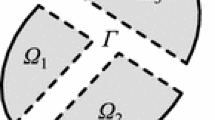Abstract
This paper presents our new development of parallel finite element algorithms for elastic–plastic problems. The proposed method is based on dividing the original structure under consideration into a number of substructures which are treated as isolated finite element models via the interface conditions. Throughout the analysis, each processor stores only the information relevant to its substructure and generates the local stiffness matrix. A parallel substructure oriented preconditioned conjugate gradient method, which is combined with MR smoothing and diagonal storage scheme are employed to solve linear systems of equations. After having obtained the displacements of the problem under consideration, a substepping scheme is used to integrate elastic–plastic stress–strain relations. The procedure outlined controls the error of the computed stress by choosing each substep size automatically according to a prescribed tolerance. The combination of these algorithms shows a good speedup when increasing the number of processors and the effective solution of 3D elastic–plastic problems whose size is much too large for a single workstation becomes possible.
Similar content being viewed by others
References
Hu N (1994). A parallel algorithm for analyzing elastic–plastic problem. Comp Struct 52(6): 1127–1133
Klaas K, Kreienmeyer M and Stein E (1994). Elastoplastic finite element analysis on a MIMD parallel-computer. Eng Comput 11: 347–355
Kacou S and Parsons ID (1993). A parallel multigrid method for history-dependent elastoplasticity computations. Comput Methods Appl Mech Eng 108: 1–21
Feriai A, Franchi A and Genna F (1996). An incremental elastic– plastic finite element solver in a workstation cluster environment, Part 1. Formulations and parallel processing. Comput Methods Appl Mech Eng 130: 289–298
Feriai A, Franchi A and Genna F (1996). An incremental elastic– plastic finite element solver in a workstation cluster environment part 2. Performance of a first implementation. Comput Methods Appl Mech Eng 130: 299–318
Sun CT and Mao KM (1988). Elastic–plastic crack analysis using a global-local approach on a parallel computer. Comput Struct 30(1/2): 395–401
Polat MU and Dokainish MA (1989). An automatic subincrementation scheme for accurate integration of elasto-plastic constitutive relation. Comput Struct 31(3): 339–347
Wissmann JW and Hauck C (1983). Efficient elastic–plastic finite element analysis with higher order stress-point algorithms. Comput Struct 17(1): 89–95
Pezeshk S and Camp CV (1995). An explicit time integration technique for dynamic analysis. Int J Numer Methods Eng 38: 2265–2281
Sloan SW (1987). Substepping schemes for the numerical integration of elastoplastic stress–strain relations. Int J Numer Methods Eng 24: 893–911
Luccioni LX, Pestana JM and Taylor RL (2001). Finite element implementation of non-linear elastoplastic constitutive laws using local and global explicit algorithms with automatic error control. Int J Numer Methods Eng 50: 1191–1212
Sloan SW and Booker JR (1992). Integration of Tresca and Mohr–Coulomb constitutive relations in plane strain elastoplasticity. Int J Numer Methods Eng 33: 163–196
Tamagnini C, Viggiani G, Chamboon R and Desrues J (2000). Evaluation of different strategies for the integration of hyoplastic constitutive equations: Application to the CLoE model. Mech Cohes Frict Mater 5: 263–289
Jakobsen KP and Lade PV (2002). Implementation algorithm for a single hardening constitutive model for frictional materials. Int J Numer Anal Methods Geomech 26: 661–681
Fellin W and Ostermann A (2002). Consisten tangent operators for constitutive rate equations. Int J Numer Anal Methods Geomech 26: 1213–1233
King RB and Sonnad K (1987). Implementation of an element-by-element solution algorithm for the finite element method on a coarse-grained parallel computer. Comput Methods Appl Mech Eng 65: 47–59
Hughes TJR, Levit I and Winget J (1983). An element-by-element solution algorithm for problems of structural and solid mechanics. Comput Methods Appl Mech Eng 36: 245–254
Kincho H. Law (1986). A parallel finite element solution method. Comput Struct 23(6): 845–858
Farhat C and Crivelli L (1989). A general approach to nonlinear FE computations on share-memory multiprocessors. Comput Methods Appl Mech Eng 72: 153–171
Owen DRJ and Hinton E (1980). Finite elements in plasticity: theory and practice. Pineridge Press, Swansea
Chen WF (2000) Constitutive equations for engineering materials. In: Plasticity and modeling, vol 2. Elsevier, Amsterdam
Dormand JR and Prince PJ (1980). A family of embedded Runge-Kutta formulae. J Comput Appl Math 6: 19C26
James ML, Smith GM and Wolford JC (1985). Applied numerical methods for digital computation. Harper & Row, New York
Hestenes MR and Stiefel E (1952). Methods of conjugate gradients for solving linear systems. J Res Natl Bureau Stand 49: 409–436
Chien LS and Sun CT (1989). Parallel processing techniques for finite element analysis of nonlinear large truss structures. Comput Struct 31(6): 1023–1029
Hill R (1948). A theory of yielding and plastic flow of anisotropic metals. Proc R Soc A 193: 281–297
William Gropp, Ewing Lusk, Anthony Skjellum (1994) Using MPI portable parallel programming with the message-passing interface. MIT Press, Cambridge
Gens A and Potts DM (1988). Critical state models in computational goemechanics. Eng Comput 5: 178–197
Crisfield MA (1997) Non-linear finite element analysis of solids and structures. In: Basic topics, vol 1. Wiley, London
Sloan SW, Abbo AJ, Sheng DC (2001) Refined explicit integration of elastoplastic models with automatic error control. Eng Comput 18(1/2):121–154. Erratum: Eng Comput 19(5/6):594–594, 2002
Author information
Authors and Affiliations
Corresponding author
Rights and permissions
About this article
Cite this article
Ding, K.Z., Qin, QH., Cardew-Hall, M. et al. Efficient parallel algorithms for elastic–plastic finite element analysis. Comput Mech 41, 563–578 (2008). https://doi.org/10.1007/s00466-007-0215-5
Received:
Accepted:
Published:
Issue Date:
DOI: https://doi.org/10.1007/s00466-007-0215-5




